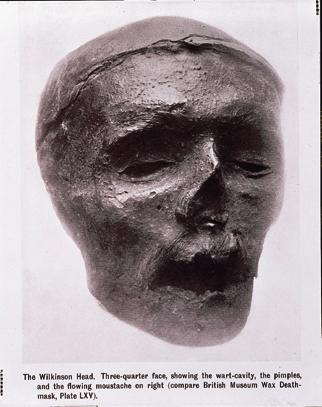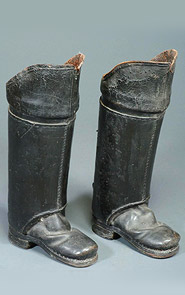There is an interesting article by John Morrill in the February issue of BBC History, announcing that he is part of a team of eight editors picked by Oxford University Press to compile a new, scholarly edition of Oliver Cromwell’s collected writings and speeches.
As Morrill says in the article, this is long overdue. The first collected edition of Cromwell’s words was Thomas Carlyle’s Letters and Speeches of Oliver Cromwell, published in 1845 and updated by S. C. Lomas in 1904. If you skip Carlyle’s commentary, it is a reasonable reference edition, but the provenance of the texts – especially where variant versions exist – is not really covered. Then there is W. C. Abbott’s Writings and Speeches of Oliver Cromwell, published between 1937 and 1947. I have all three volumes of this and the only good thing about them is that one copy used to be owned by Brian Wormald and still has lot of notes he made tucked into the dustjacket. That, and that in an emergency it can double as an effective doorstop. Otherwise, it is a pig of an edition to use. Abbott’s accompanying history of the period takes up most of the space, it’s really difficult to find what you’re looking for, and like Carlyle/Stainer it doesn’t deal with variant versions.
Morrill’s argument in the article – which he has made before in the Historical Journal, and to a generation of undergraduates like me who took his Cromwell special subject in the late 1990s – is that being clear about variant versions matters. One of the examples he gives in the article is the famous one, pointed out by Austin Woolrych in his study of the Barebones Parliament, of Cromwell’s speech at the opening of that body. One version, recorded in 1654, is as follows:
I confess I never looked to see such a day as this – it may not be nor you neither – when Jesus Christ should be so owned as He is, at this day, and in this work. Jesus Christ is owned this day by your call, and you own Him by your willingness to appear for Him; and you manifest this, as far as poor creatures can, to the day of the power of Christ.
Another, recorded a century later, runs like this:
I confess I never looked to see such a day as this – it may not be nor you neither – when Jesus Christ should be so owned as He is, at this day, and in this work. Jesus Christ is owned this day by you all, and you own Him by your willingness to appear here; and you manifest this, as far as poor creatures can, to a day of the power of Christ.
The differences are small but important. In the first version, Cromwell is far more radical. Members of the Parliament have called forth the spirit of Christ through their presence, and the day itself is “the day of the power of Christ”, an apocalyptic climax to the struggles of the past eleven years. In the second version, Cromwell calls it “a day of the power of Christ”, which softens its millenarianism. Representatives have been summoned by Christ, not the other way around.
Establishing the provenance of these variant versions more precisely, and weighing up their likely accuracy, could make a fundamental difference to how historians interpret this and many other of Cromwell’s actions. If Morrill and his co-editors can pull this off, it will be a fantastic achievement. They ought to produce a definitive edition of Cromwell’s recorded words. As Morrill puts it:
Cromwell will come alive in much the same way as a Great Master painting takes on a new and different life when it is cleaned and restored.
I agree with the sentiment of this statement, but part of me wonders about the extent to which his work will “restore” Cromwell’s original words. A new version of Cromwell will be born, it’s true: but whether it will be the original Cromwell resurrected is a different matter. Like any historian of Cromwell, the editors will still have to wrestle with numerous ambiguities in what survives of his words. One example that springs to mind is Bulstrode Whitelocke’s famous description – or more accurately, descriptions – of a night-time encounter with Cromwell in Hyde Park in November 1652. Here is the version in a manuscript ‘diary’ written up by Whitelocke years after the event:
But suddeinly and unexpectedly Crom brake forth in this expression, What if a man should take uppon him to be King? Wh answerd that it would be more to his prejudice than advantage to doe so.
And here is the version in Whitelocke’s Annals:
Cromwell.—” What if a man should take upon him to be King?”
Whitelock.—” I think that remedy would be worse than the disease.”
Cromwell.—” Why do you think so?”
Whitelock.—” As to your own person, the title of King would be of no advantage, because you have the full kingly power in you already, concerning the militia, as you are General. So that I apprehend less envy, and danger, and pomp, but not less power and opportunities of doing good, in your being General, than would be if you had assumed the title of King.”
Here we have two versions of an encounter written retrospectively – both in the third person, but one in direct speech and one in reported speech. Which is more accurate? Has Whitelocke remembered events correctly, and dated them properly? Has he embellished, or even made things up? Given what we know of Cromwell’s frustrations with the Rump Parliament at this time, it is not implausible that this conversation took place. (One might add that given what we know about Whitelocke, it’s not implausible that it’s exaggerated, either). But it would be more plausible if it had taken place in 1657, when the offer of kingship was for a time seriously on the table. From what we know of both Cromwell and Whitelocke, we can contextualise this source to some extent. But ultimately, we can never know whether it reflects Cromwell’s actual words.
A similar problem might be raised with those of Cromwell’s words intended for publication. Cromwell wrote detailed accounts to William Lenthall, Speaker of the Commons, of battles in which he had commanded Parliamentary forces. Many of these were ordered to be published by Parliament, and formed part of an increasingly sophisticated propaganda war as the 1640s went on. We rely on these letters for much of our insight into Cromwell’s military and political career during the 1640s. One example amongst many is Cromwell’s famous – or infamous – account of the sack of Drogheda in September 1649. This is a critical source for trying to understand what happened during the siege, and for unpicking Cromwell’s attitude towards the Irish. It includes this grim account of the assault:
And indeed, being in the heat of action, I forbade them to spare any that were in arms in the town, and, I think, that night they put to the sword about 2,000 men, diverse of the officers and soldiers being fled over the bridge into the other part of the town, where about one hundred of them possessed St. Peter’s church-steeple, some the west gate and others a strong round tower next the gate called St. Sunday’s. These being summoned to yield to mercy, refused, whereupon I ordered the steeple of St. Peter’s Church to be fired, where one of them was heard to say in the midst of the flames: “God damn me, God confound me; I burn, I burn.”
It also has this oft-quoted phrase:
I am persuaded that this is a righteous judgment of God upon these barbarous wretches, who have imbrued their hands in so much innocent blood; and that it will tend to prevent the effusion of blood for the future, which are the satisfactory grounds to such actions, which otherwise cannot but work remorse and regret.
This letter survives in a number of printed sources: in the “official” pamphlet ordered to be published by Parliament, and reprinted in various newsbooks. But do we know that its contents are actually Cromwell’s words? As far as I know, Cromwell’s original letter does not survive. We don’t know whether the Council of State, or the clerk to Parliament, or the printers, may have made alterations or amendments. And even this aside, we also know very little about how Cromwell composed these letters. John Rushworth is known to have ghost-written equivalent letters sent back to Parliament by Thomas Fairfax. Did Cromwell write these letters on his own, or with the help of others under his command? Were they “tidied up” before publication?
My own answer is that I don’t really know. If anyone does, it’s John Morrill, which is why the work he and his co-editors are taking forward is so important. The Cromwell that emerges from their work will no doubt be much more sophisticated portrait than anything produced so far. But to extend Morrill’s metaphor, bits of it will be still be smudged or frayed at the edges. They will probably always remain that way. That is part of the challenge for anyone studying Cromwell, but it’s also what makes him such a fascinating and controversial figure.
As a footnote, a podcast by Professor Morrill about the work on a new edition of Cromwell’s words will go up on the BBC History site on 12 February.









